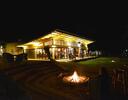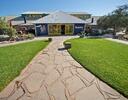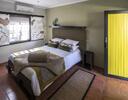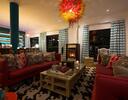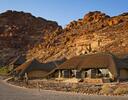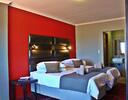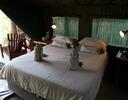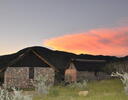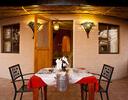Best of Namibia
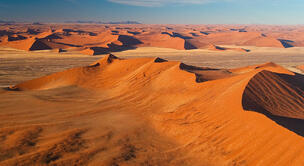
If Namibia is 'Africa for beginners', as is often said, what a wonderful place to start.
Natural Beauty
Few countries in Africa can match Namibia's sheer natural beauty. The country's name derives from its (and the world's) oldest desert, the Namib, and there are few more stirring desert realms on the planet, from the sand sea and perfect dead-tree valleys at Sossusvlei to the otherworldliness of sand dunes plunging down to the sea at Sandwich Harbour and the Skeleton Coast. Inland, running through the heart of the country, a spine of mountains creates glorious scenery – the Naukluft Mountains, the Brandberg, Spitzkoppe, Damaraland and the jaw-dropping Fish River Canyon. With rivers and wetlands in the Caprivi Strip and the endless gold-grass plains of the Kalahari, it's difficult to think of an iconic African landscape that Namibia doesn't possess.
Prolific Wildlife
Make no mistake: Namibia is one of Southern Africa's best places to watch wildlife, at least in the country's north. Etosha National Park belongs in the elite wildlife-watching destinations – big cats, elephants, black rhinos and plains game in abundance. Two other areas are emerging as complements to Etosha. Damaraland is a wonderful place to see desert-adapted elephants and lions, and also happens to host Africa's largest population of free-ranging rhinos – rhino tracking is a real highlight here. Over in the Caprivi Strip, the wildlife is returning, with Bwabwata and Nkasa Rupara becoming wonderfully rich parks to explore. This being Namibia, there are private reserves (Okonjima and Erindi premier among them) as well as game farms that serve as havens for rescued wildlife.
Remote Wilderness
At some point during your stay in Namibia, you may well look around and wonder if you've fallen off the end of the earth. This tends to happen most often along the country's barren, sandswept coastline. From Walvis Bay to Lüderitz, the desert that forms the Sperrgebiet National Park is almost a truly trackless waste for much of its territory, but tours out of the latter can take you across it. Away to the north, along the Skeleton Coast to the Angolan border, shipwrecks along the shore only heighten the sensation that humankind is here very much at the mercy of the elements. Then there's the Kalahari, the Nyae Nyae Conservancy…
Human Story
Namibia's human story is every bit as interesting as that written in the rocks, soil and sand of the country. Through their architecture and museums, Lüderitz, Swakopmund and Windhoek tell a complicated story of colonial settlement and oppression, while elsewhere the chance to interact with the many traditional people who call Namibia home will likely provide you with some of your most memorable moments. The Himba, in the country's far northwest, and the San in the east, in particular are soulful people with whom an encounter carries an older, deeper wisdom.
Main attractions covered as part of the tour ...
• Kalahari Desert
• Scenic Fish River Canyon (second largest in the World)
• The Namib‚ Sea of Sand’, Sossusvlei and Dead Vlei – UNESCO World Heritage region
• Sesriem Canyon and Solitaire oasis
• Coastal town of Swakopmund and lunar landscape of the ‚Moon Valley’
• Historical Cape Cross and one of the largest in Africa, colony of fur seals
• Bushmen rock engravings at Twyfelfontein – UNESCO World Heritage Site
• Ethnic experience during visit with Damara & Himba village
• Wildlife Sanctuary – Etosha National Park
Itinerary
- Day 1
Windhoek to Kalahari Desert
Pick up from Hosea Kutako International Airport at Windhoek and begin travel to south into Kalahari Desert, on the way passing small towns and farm holdings. [flight should arrive before 12 noon]
A voyage to the Kalahari is akin to catapulting into a parallel universe. It’s a surreal Alice-through-the-looking-glass experience where you feel really small and everything around you looms larger than life. Timeless and magical, solitary stretches of space spin on into infinity; and shapes distort under a blanket of scorching desert heat.
A mystifying collage of fiery sunsets and shifting crimson sands, of lush green fields and gushing waterfalls, magnificent wildlife reserves and tidy vineyards, this region will enchant long after you depart.
Arrival at the lodge in the Kalahari where you can enjoy an afternoon game drive and sun downer in the evening.
During this game drive, a guide will take you to dunes up to 30 meters high in an open off-road vehicle. He has extensive knowledge about the region and its flora and fauna so he can not only provide you exciting information about the Namibian nature, but also offers a perfect view on African wildlife.
The vehicle is not only a means of transport, but also your protection against potentially dangerous animals. Because with a game drive you will be closer to the fauna of Africa than ever before. On this excursion you will gain intimate insights into the life of majestic creatures such as leopards, lions, zebras, baboons or desert elephants. You can safely and comfortably enjoy this fascinating natural experience on a game drive.
Meals: dinner.
Accommodation: 1 night in the Kalahari at Kalahari Anib Lodge or similar.
Distance: 500 km (tarred and gravel roads).
Duration: around 7 hours with the stop-overs. - Day 2
Kalahari to Fish River Canyon
Depart Kalahari heading south for adventure at the Fish River Canyon, second largest canyon in the World, after the famous Grand Canyon. Unique place for spectacular landscape photography!
Nowhere else in Africa will you find anything quite like Fish River Canyon. Whether you're getting a taste of the sheer scale and beauty of the place from one of the lookouts, or hiking for five days to immerse yourself in its multifaceted charm, Fish River Canyon is a special place.
At one level, the numbers don’t lie: the canyon measures 160km in length, up to 27km in width, and the dramatic inner canyon reaches a depth of 550m. But as impressive as these numbers are, it’s difficult to get a sense of perspective without actually experiencing the enormous scope of the canyon, something best done on the monumental five-day hike that traverses half its length. The reward is nothing less than an unforgettable relationship with one of Africa’s greatest natural wonders.
Early morning or at the sunset, canyon and surrounding desert comes to life with hues, colours and shades – what provides the best lighting for artistic captures, painted with the raising or setting sun.
Afternoon visit to the Fish River Canyon.
Accommodation: 1 night at Canyon Roadhouse Lodge or similar.
Meals: breakfast and dinner
Distance: Around 150 km on the gravel roads during the day. - Day 3
Fish River Canyon to Sossusvlei, Namib Desert
Depart Fish River Canyon moving towards Sossusvlei – highest and oldest dunes on Earth
Sossusvlei, a large ephemeral pan, is set amid red sand dunes that tower up to 325m above the valley floor. It rarely contains any water, but when the Tsauchab River has gathered enough volume and momentum to push beyond the thirsty plains to the sand sea, it’s completely transformed. The normally cracked dry mud gives way to an ethereal blue-green lake, surrounded by greenery and attended by aquatic birdlife, as well as the usual sand-loving gemsboks, and ostriches.
This sand probably originated in the Kalahari between three and five million years ago. It was washed down the Orange River and out to sea, where it was swept northward with the Benguela Current to be deposited along the coast. The best way to get the measure of this sandy sprawl is to climb a dune, as most people do. And of course, if you experience a sense of déjà vu here, don’t be surprised – Sossusvlei has appeared in many films and advertisements worldwide, and every story ever written about Namibia features a photo of it.
On the way admiring picturesque vistas and incredible, desert landscape
After the long day’s drive, you are comfortably settled for an appetizing dinner and deserved rest at the stylish lodge near Sossusvlei.
Meals: breakfast and dinner
Accommodation: 2 nights at Sossusvlel at Namib Desert Lodge or similar
Distance: around 550 km (tarred and gravel roads).
Duration: around 8 hours with the stop-overs. - Day 4
Sossusvlei & Deadvlei
Early morning, in the light of the rising sun, witness an excellent view of the highest dunes in the World.
Climbing Dune 45 or/and one of the highest in the area‚ Big Daddy or Big Mama
Off-road drive and adventure at Dead Vlei (valley) where expressive, dried up trees stand among the dunes in the heart of the desert.
Although it's much less famous than its neighbour Sossusvlei, Deadvlei is actually the most alluring pan in the Namib-Naukluft National Park – it's arguably one of Southern Africa's greatest sights. Sprouting from the pan are seemingly petrified trees, with their parched limbs casting stark shadows across the baked, bleached-white canvas. The juxtaposition of this scene with the cobalt-blue skies and the towering orange sands of Big Daddy, the area's tallest dune (325m), is simply spellbinding.
In the early afternoon, visit at the interesting rock formation of the Sesriem Canyon. Spaciousness, magnificence, splendour and calm forever imprints lasting impressions and memories in your heart – turning your desert adventure into a photographic discovery!
Meals: breakfast and dinner
Distance: 150 km during the course of the day (gravel and sandy roads). - Day 5
Sossusvlei to Swakopmund
Today depart Sossusvlei traveling through the African savannah, towards the Kuiseb River, where huge, orange dunes suddenly stop at the dry river bed of the Kuiseb, as if held by an invisible, giant hand.
After arrival in Walvis Bay visit to the Lagoon where flocks of Flamingos are gathered.
Afterwards, travelling along the Atlantic Coast, we arrive at the small town – oasis of Swakopmund, where past, German, colonial architecture melts with modern trends and sandy dunes of the Namib. Desert charms us with its characteristic atmosphere and magnificent vistas.
Sandwiched between Atlantic rollers and the Namib Desert, Swakopmund is one of those great traveller way stations along the African road. At once Namibia's adventure capital and a surreal colonial remnant, part destination in its own right and part launch pad for an exploration of the Skeleton Coast and Namib Desert, this is a city with as much personality as it has sea frontage. Like Lüderitz on the south coast, with its half-timbered German architecture, seaside promenades and pervasive Gemütlichkeit (a distinctively German appreciation of comfort and hospitality), Swakopmund, especially out of season, can feel like a holiday town along Germany’s North Sea and Baltic coasts transplanted onto African soil. But the city is also thoroughly African and its multidimensional appeal means that most people end up staying longer than they planned.
Optional activities at Swakopmund [to be covered based on available time] :
• Visit to the‚ lunar landscape’ and Welwitchia mirabilis trails - botanic attraction, known as the‚ living fossil’; considered to be one of the oldest and most original plants on Earth.
• Quadbike ride into the dunes and rolling hills of the Namib. Price per person Euro 50.
• City tour of Swakopmund and visit to the Crystal Gallery . Entrance euro 5 per person.
• Visit to National Marine Aquarium. Entrance euro 5 per person.
• Snake Park. Entrance euro 5 per person.
• Street-craft-market.
• Bicycle tour of the Mondesa township.
• Skydiving
• Fishing offshore
Meals: breakfast and dinner
Accommodation: 1 nights in Swakopmund at The Delight or similar
Distance: 350 km (gravel roads).
Duration: around 6 hours with the stop-overs. - Day 6
Swakopmund to Damaraland, Twyfelfontein
Today depart from Swakopmund on the salt road along the Atlantic Coast which will take us further north … short visit to to Zeila Shipwreck on way ... A Rare opportunity to find remains of sunken ships dating back to the 1800's. Putting together pieces of the maritime puzzle.
Further on, visit to the largest in Africa, fur seal colony.
Short stop-over at the historical Cape Cross, where in 1486, Portuguese sailor Diego Cao set up the granite cross in tribute of the King of Portugal, after landing at the Namibian coast.
Turning east, inland, we are on route to the mountainous Brandberg Massif.
Arrival at the lodge at around 4pm, with an afternoon visit to the Twyfelfontein area which is the second UNESCO world heritage site on this incredible journey.
From the glorious rock formations of Spitzkoppe, Erongo and the Brandberg in the south to the equally glorious red-rock, wild-desert mountains around Palmwag in the north, Damaraland is one of Namibia's most dramatic collections of landscapes. Hidden in the rocky clefts is Twyfelfontein, which along with the Brandberg contains some of Southern Africa’s finest prehistoric rock art and engravings, and there's even a petrified forest nearby, as well as palm-fringed, oasislike valleys. Damaraland is also one of Southern Africa's most underrated wildlife-watching areas. One of Namibia's last ‘unofficial’ wildlife regions, it's home to critically endangered black rhinos, desert-adapted lions and elephants, as well as the full range of Namibia specialities such as gemsbok, zebra, giraffe and spotted hyena.
This combination of wild landscapes and wild creatures is Damaraland at its best.
Meals: breakfast and dinner
Accommodation: 1 nights in Damaraland at Twyfelfontein Country Lodge or similar.
Distance: about 450 km (salt and gravel roads).
Duration: around 8 hours with the stop-overs. - Day 7
Twyfelfontein to Opuwo
After breakfast, we venture further into Kaokoland, Opuwo, capital of this northern region.
In the Herero language, Opuwo means 'The End', which is certainly a fitting name for this dusty collection of concrete commercial buildings ringed by traditional rondavels (round huts with conical roofs) and huts. While first impressions are unlikely to be very positive, a visit to Opuwo is one of the cultural highlights of Namibia, particularly for anyone interested in interacting with the Himba people. As the unofficial capital of Himbaland, Opuwo serves as a convenient jumping-off point for excursions into the nearby villages, and there is a good assortment of lodges and campsites to choose from.
The next day we will meet semi-nomadic Himba people. One of the last, pastoral tribes on Earth, who continue to keep their traditional ancient way of life, as they did for hundreds of years. Unique chance for ethnic photography!
Meals: breakfast and dinner.
Accommodation: 1 night Opuwo area.
Distance: around 450 km on gravel and tarred roads.
Duration: 8 hrs with visiting and stop-overs. - Day 8
Opuwo to Epupa Falls
After breakfast we have a morning visit to the traditional Himba village and then bid farewell to the Himba people and heading further north towards the mighty Kunene River and Epupa Falls.
At Epupa, which means 'Falling Waters' in Herero, the Kunene River fans out into a vast flood plain and is ushered through a 500m-wide series of parallel channels, dropping a total of 60m over 1.5km. The greatest single drop, an estimated 37m, is commonly identified as the Epupa Falls. Here the river tumbles into a dark, narrow, rainbow-wrapped cleft, a stunning sight to behold, particularly when the Kunene is in peak flow from April to May.
Although you’d think this remote corner of the Kaokoveld would be off the tourist trail, Epupa Falls is a popular detour for overland trucks and organised safaris, and can get swamped with tourists. But if you’re passing through the area, the falls are certainly worth the detour – the sight of so much water in the middle of the dry Kaokoveld is miraculous to say the least, and if the pools are free from crocs, a dip is a possibility.
Afternoon arrival at the falls in time for some great sun down photography. The Kunene River creates a natural border between Northern Namibia and Angola.
Meals: breakfast and dinner.
Accommodation: 1 night Epupa area.
Distance: around 180 km on gravel roads.
Duration: 4/5 hrs with visiting and stop-overs. - Day 9
Epupa to Etosha National Park
After breakfast we head south east; on route to one of the largest and considered to be one of the most loved, nature sanctuaries of Africa – Etosha National Park.
Etosha, often called the ‚treasure of Namibia’ is dedicated to protect wildlife of African bush and savannah.
Etosha National Park covering more than 20,000 sq km, is one of the world’s great wildlife-viewing venues. Unlike other parks in Africa, where you can spend days looking for animals, Etosha’s charm lies in its ability to bring the animals to you. Just park your car next to one of the many water holes, then wait and watch while a host of animals – lions, elephants, springboks, gemsboks etc – come not two by two but by the hundreds.
Etosha's essence is the vast Etosha Pan, an immense, flat, saline desert that, for a few days each year, is converted by rain into a shallow lagoon teeming with flamingos and pelicans. In contrast, late in the dry season, everything, from the elephants to the once-golden grasslands, seems cast, spectrelike, in Etosha’s white chalky dust. And what wildlife there is! Even if you’ve had a taste of African wildlife watching previously, you are likely to be mesmerised by it here.
In the afternoon arrival at Etosha and, should the time allow for it, afternoon game drive in the park.
Meals: breakfast and dinner.
Accommodation: 3 nights at Etosha in Okaukuejo and Halali camps or similar.
Distance: around 250 km (tarred and gravel roads).
Duration: around 4 hours with the stop-overs. - Day 10
Etosha National Park - Game Drives
Early morning, we are on the safari trail, tracking the Big Game, and travelling deep into Etosha in search of the wild!
Explore the beautiful landscapes and diverse wildlife of Etosha National Park. Etosha is home to lions, wild dogs, leopards, cheetahs, rhinos, an enormous population of elephants and much more. Experience close encounters with wildlife and get off the beaten track in a 4x4. Choose to take a full or half-day tour by selecting the relevant option upon check out.
Start the tour with pickup from your hotel. Begin your journey by venturing through the Anderson Gate near Okaukuejo. On arrival at one of the park lodges, set out on your game drive with an experienced guide.
Travel close to several watering holes in an attempt to catch the animals during their feeding time. Then, at midday, enjoy a sumptuous lunch at one of the lodges (please note that lunch is not included in the activity price).
After lunch, as the afternoon heat begins to cool, head out on your second game drive. Marvel at how the animals gather again near the water holes to cool off and feed. Then, as the sun begins to set, experience some of the best game viewings. At the end of your second game drive, transfer back to your hotel where your memorable adventure will end.
With the eye of the camera capturing antelopes: springbuck, wildebeest, kudu, impala, gemsbok, hartebeest, oryx and steenbuck.
Looking out for magnificent, African elephants, exotic giraffes, shy rhinos, playful jackals, curious warthogs and cheeky hyenas – nature overwhelms and more then surpasses your expectations!
Distance: 200 km on gravel roads of Etosha Park.
Meals: breakfast and dinner.
Duration: Full day game drive - Day 11
Etosha National Park - Game Drives
Full day Game Drives
Meals: breakfast and dinner.
Distance: around 250 km (tarred and gravel roads).
Duration: full day game drive - Day 12
Etosha National Park to Windhoek
Farewell’ to Etosha.
We now travel south, to Windhoek, capital of Namibia.
On the way short visit to open craft market at Okahandja.
Drop off to Windhoek airport for onward flight
Meals: breakfast
Distance: 250 km (tarred road).
Duration: around 4 hours with the stop-overs.
Notes
Round the Year Destination ... Entention availalbe to countries across Africa ... Botswana, South Africa, Kenya, Tanzania, etc.
Hotels
Tour Inclusions - Best of Namibia
11 nights’ lodge accommodation
Transportation by vehicle of suitable size
Daily breakfast & dinner
Experienced tour guide for the entire tour
National park entrance fee
Full-day unlimited game drives in Etosha National Park (sunrise till sunset) in the provided tour vehicle
Water in the Vehicle
Notes on itinerary
All our itineraries are "Just for Ideas" ... We will get to know you and customise an itinerary just for you that matches your requirements ... dates of travel, category of hotels, preferred airline, flexibility in choosing sightseeing, mode of travel between cities, etc.
Many of our clients have us design more relaxing, slower paced holidays with more in-depth experiences whereas some simply want to visit various destinations and cover only the highlights.
Together, we will determine the ideal route, pace of travel, accommodations, levels of pampering, style of touring, sightseeing to be included, dining preferences, adventure levels, options to meet locals, dates of travel & much more ! and based on this arrive at a price.
Do feel free to get in touch with us by a quick call on +91 79 29602961 or a short mail on mail@destinations4india.com ... Looking forward




